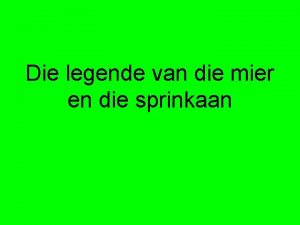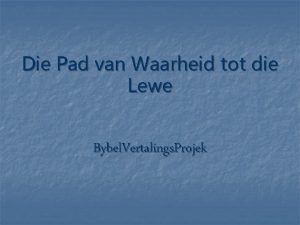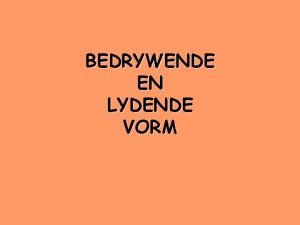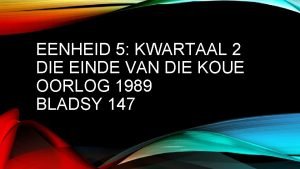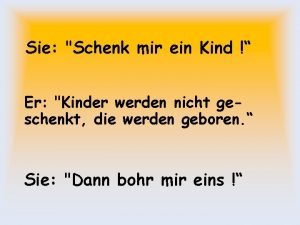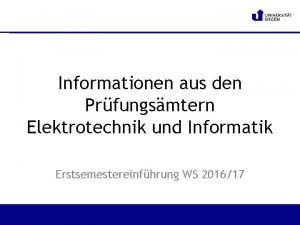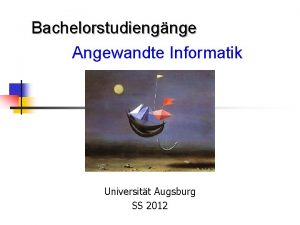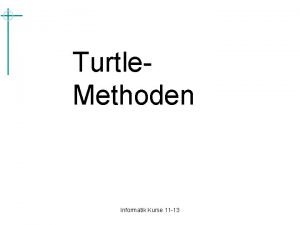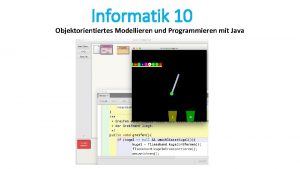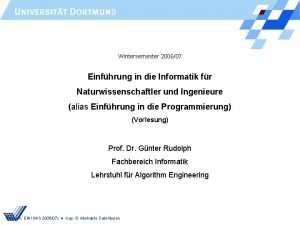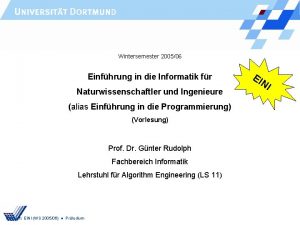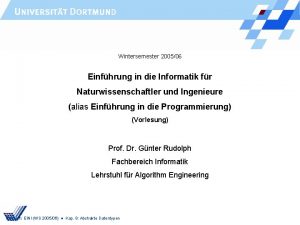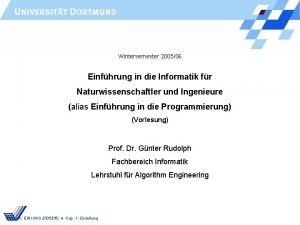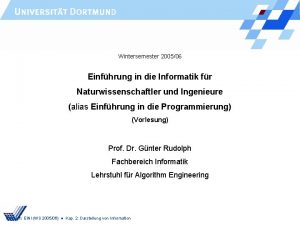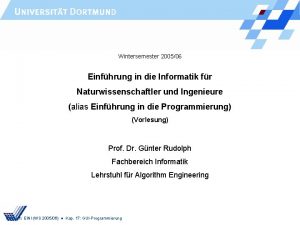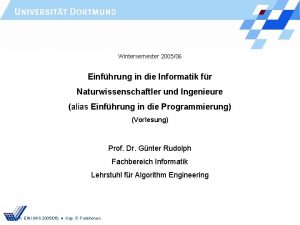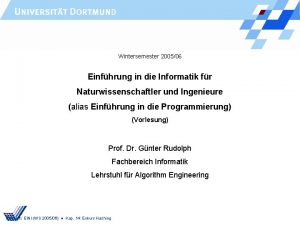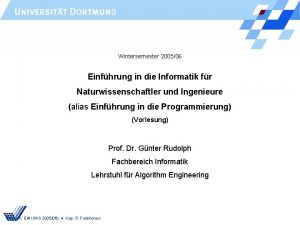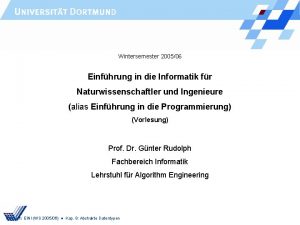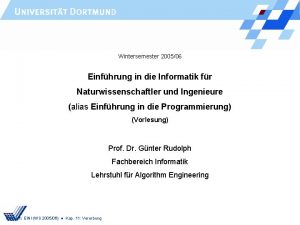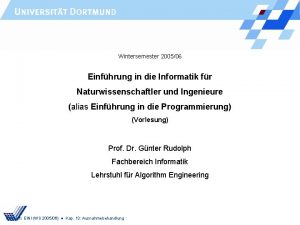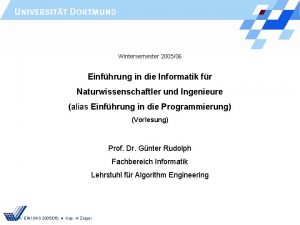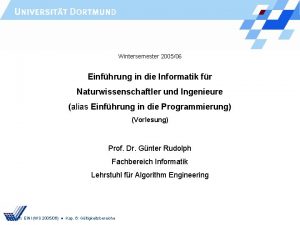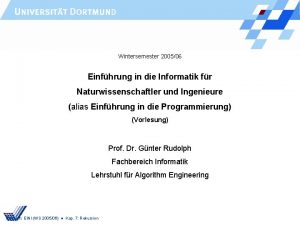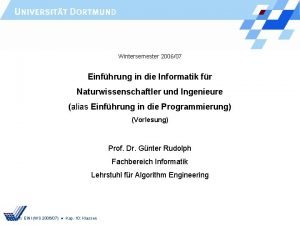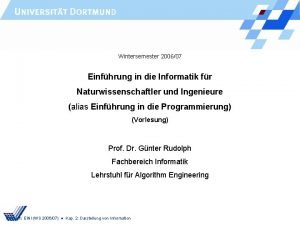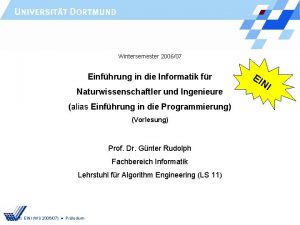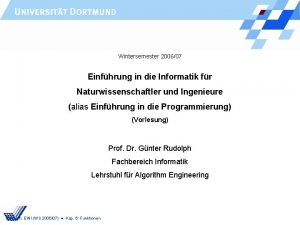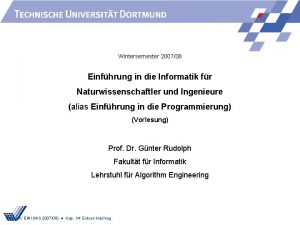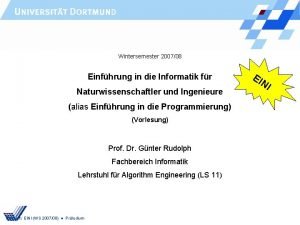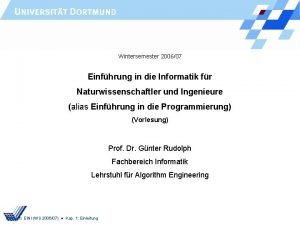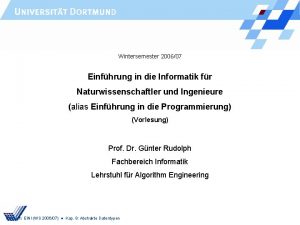Wintersemester 200506 Einfhrung in die Informatik fr Naturwissenschaftler


























- Slides: 26

Wintersemester 2005/06 Einführung in die Informatik für Naturwissenschaftler und Ingenieure (alias Einführung in die Programmierung) (Vorlesung) Prof. Dr. Günter Rudolph Fachbereich Informatik Lehrstuhl für Algorithm Engineering Rudolph: EINI (WS 2005/06) ● Kap. 2: Darstellung von Information

Kapitel 2: Darstellung von Information Inhalt ● Einfache Datentypen (Fortsetzung) ● Erste Programme (mit Ausgabe) ● Exkurs: Grammatiken Rudolph: EINI (WS 2005/06) ● Kap. 2: Darstellung von Information 2

Darstellung von Information Einfache Datentypen ● Zeichen ■ Ein Zeichen wird in einem Byte gespeichert (char) ■ Zuordnung: Zeichen ↔ Zahl (Code) ■ ASCII (American Standard Code for Information Interchange), 7 -Bit-Code 0 NUL SOH STX EOT ENQ ACK BEL 16 DLE DC 1 DC 2 DC 3 DC 4 NAK SYN ETB CAN 32 SP ! “ # $ % & ‘ ( ) * 48 0 1 2 3 4 5 6 7 8 9 64 @ A B C D E F G H 80 P Q R S T U V W 96 ` a b c d e f 112 p q r s t u v Rudolph: EINI (WS 2005/06) ● Kap. 2: Darstellung von Information BS TAB FF CR SO SI FS GS RS US + , - . / : ; < = > ? I J K L M N O X Y Z [ ] ^ _ g h i j k l m n o w x y z { | } ~ DEL EM LF VT SUB ESC Steuerzeichen 3

Darstellung von Information Einige wichtige nicht druckbare Steuerzeichen: horizontal tabulation null space NUL SOH STX EOT ENQ ACK BEL DLE DC 1 DC 2 DC 3 DC 4 NAK SYN ETB CAN SP ! “ # $ % & ‘ ( ) * 0 1 2 3 4 5 6 7 8 9 @ A B C D E F G H P Q R S T U V W ` a b c d e f p q r s t u v Rudolph: EINI (WS 2005/06) ● Kap. 2: Darstellung von Information BS line feed TAB FF CR SO SI FS GS RS US + , - . / : ; < = > ? I J K L M N O X Y Z [ ] ^ _ g h i j k l m n o w x y z { | } ~ DEL EM LF carriage return VT SUB ESC delete 4

Darstellung von Information Zeichen ● Zeichen werden gemäß ihrem Code als Zahl gespeichert deshalb kann man mit Zeichen rechnen: char c = ‘ 7‘; Code von ‘ 7‘ ist 55 Resultat: int zahl = c – ‘ 0‘; Code von ‘ 0‘ ist 48 zahl = 7 ● … und man kann Zeichen vergleichen: ‘a‘ < ‘b‘ ist wahr, weil 97 < 98 ● Erst bei der Ausgabe wird Datentyp char wieder als Zeichen interpretiert. Rudolph: EINI (WS 2005/06) ● Kap. 2: Darstellung von Information 5

Darstellung von Information Zeichen ● Datendefinition: char Zeichen; ● Zuweisung: Zeichen = ‘x‘; ● Darstellbare Zeichen: ■ Buchstaben: ‘a‘ bis ‘z‘ und ‘A‘ bis ‘Z‘ ■ Ziffern: ‘ 0‘ bis ‘ 9‘ ■ Satzzeichen: z. B. ‘!‘ oder ‘: ‘ ■ Sonderzeichen: z. B. ‘@‘ oder ‘>‘ oder ‘}‘ oder Leerzeichen ■ Steuerzeichen mit Fluchtsymbol (Umschalter): a alarm (BEL) “ Anführungsstriche b backspace ‘ Hochkomma t horizontal tabulator (TAB) ? Fragezeichen n new line Rudolph: EINI (WS 2005/06) ● Kap. 2: Darstellung von Information \ backslash 6

Darstellung von Information Zeichenketten (Strings) Datendefinition etc. kommt später! ● Aneinanderreihung von Zeichen ● Gekennzeichnet durch doppelte Hochkommata: “ ● Beispiele: ■ “Dies ist eine Zeichenkette!“ Dies ist eine Zeichenkette! ■ “Das ist jetztnneu. “ Das ist jetzt neu. ■ ““The C++ Programming Language“ntby B. Stroustrup“ “The C++ Programming Language“ by B. Stroustrup Rudolph: EINI (WS 2005/06) ● Kap. 2: Darstellung von Information 7

Darstellung von Information Das erste C++ Programm: #include <iostream> int main() { std: : cout << “Das ist eine Zeichenkette!“ << ‘n‘; return 0; } ● #include <iostream> bindet Ein-/Ausgabemöglichkeit aus Bibliothek ein ● int main() kennzeichnet Hauptprogramm, gibt Datentyp integer zurück ● std: : cout ist der Ausgabestrom; alles rechts von << wird ausgegeben ● return 0 gibt den Wert 0 an das Betriebssystem zurück (0: alles OK!) Rudolph: EINI (WS 2005/06) ● Kap. 2: Darstellung von Information 8

Darstellung von Information Noch ein C++ Programm: #include <iostream> #include <climits> int main() { std: : cout << "int: << INT_MIN << INT_MAX return 0; } " << ". . . " << std: : endl; ● #include <climits> bindet Konstanten für Wertebereiche ein ● INT_MIN und INT_MAX sind Konstanten aus Bibliothek climits ● std: : endl ist eine Konstante für Beginn einer neuen Zeile Rudolph: EINI (WS 2005/06) ● Kap. 2: Darstellung von Information 9

Darstellung von Information Einfache Datentypen ● Logischer Datentyp bool ■ Zum Speichern von Wahrheitswerten „wahr“ und „falsch“ ■ Wertevorrat: true und false ■ Datendefinition: bool b; ■ Zuweisung: oder: b = true; int x = 9; b = x > 7; ■ Zum Überprüfen von Bedingungen ■ Operationen: Name C/C++ AND && b && x < 7 OR || b || x > 8 NOT ! Rudolph: EINI (WS 2005/06) ● Kap. 2: Darstellung von Information Beispiel !b 10

Darstellung von Information Wahrheitstafeln A B A && B A || B A !A false false true false true true false true true false Priorität der Operatoren 1. NOT 2. AND 3. OR Rudolph: EINI (WS 2005/06) ● Kap. 2: Darstellung von Information 11

Darstellung von Information Weitere ableitbare Operationen A NAND B !(A && B) A NOR B !(A || B) A B (Implikation) A || !B A XOR B (Antivalenz) !A && B || A && !B || && ! && B A Rudolph: EINI (WS 2005/06) ● Kap. 2: Darstellung von Information A ! B 12

Darstellung von Information ● Auswertung von links nach rechts ● Abbruch, sobald Ergebnis feststeht: ■ A && false = false ■ A || true = true ● Beispiel: bool A = false, B = true; || true ! && && B A Rudolph: EINI (WS 2005/06) ● Kap. 2: Darstellung von Information A keine Auswertung ! B 13

Darstellung von Information ● Boolesche Ausdrücke ■ Vergleiche: < <= > kleiner oder gleich größer >= größer oder gleich == gleich != ungleich Achtung: == testet auf Gleichheit = wird bei einer Zuweisung verwendet Rudolph: EINI (WS 2005/06) ● Kap. 2: Darstellung von Information 14

Darstellung von Information Wofür werden boolesche Ausdrücke gebraucht? ● … um Bedingungen formulieren zu können ● … um den Kontrollfluss steuern zu können ● … für Fallunterscheidungen: if Bedingung wahr then mache etwas; #include <iostream> int main() { int a = 10, if (a < b) if (a > b) if (a == b) return 0; } b = 20; std: : cout << “kleiner“; std: : cout << “groesser“; std: : cout << “gleich“; Rudolph: EINI (WS 2005/06) ● Kap. 2: Darstellung von Information sp ä me ter hr 15

Darstellung von Information Anmerkung: ● In Programmiersprache C und vor 1993 auch in C++ existierte kein boolescher Datentyp! ● Stattdessen: Simulation mit Datentyp int ● Konvention: Wert ungleich Null bedeutet true sonst false ● Beispiele: ■ int x = 8; if ( x ) x = 0; ■ char c = ‘y‘; if ( c ) c = ‘n‘; ■ Das ist auch jetzt noch möglich! Empfehlung: Besser den booleschen Datentyp verwenden! Rudolph: EINI (WS 2005/06) ● Kap. 2: Darstellung von Information 16

Exkurs: Grammatiken Woher weiß man, was man in C++ schreiben darf und was nicht? ● Natürliche Sprache festgelegt durch - Alfabeth - Orthografie - Wortbedeutungen - Grammatik ● Aktueller C++ Standard: ISO/IEC 14882: 2002 ● Es wurde u. a. eine formale Grammatik für C++ festgelegt (für alle verbindlich). Rudolph: EINI (WS 2005/06) ● Kap. 2: Darstellung von Information 17

Exkurs: Grammatiken Grafische Darstellung Ziffer : = 0 1 2 3 4 5 6 7 8 9 Ohne Pfeile: „von links nach rechts, von oben nach unten“ Ziffernfolge: = Ziffer Rudolph: EINI (WS 2005/06) ● Kap. 2: Darstellung von Information 18

Exkurs: Grammatiken Ganzzahl mit Vorzeichen : = + Ziffernfolge Festkommazahlen : = + Ziffernfolge Rudolph: EINI (WS 2005/06) ● Kap. 2: Darstellung von Information . Ziffernfolge 19

Exkurs: Grammatiken Grafische vs. textuelle Darstellung von Grammatiken ● Grafische Darstellung anschaulich aber Platz raubend ● Textuelle Darstellung kompakter und automatisch zu verarbeiten Ziel ● Beschreibung von syntaktisch korrekten C++ Programmen Konkreter ● Sie sollen lernen, formale Grammatiken zu lesen und zu verstehen, - um sie in dieser Veranstaltung für ihre Zwecke nutzen zu können, - um einen fundamentalen Formalismus in der Informatik kennen zu lernen, - um andere Programmiersprachen leichter erlernen zu können. Rudolph: EINI (WS 2005/06) ● Kap. 2: Darstellung von Information 20

Exkurs: Grammatiken Definition Eine kontextfreie Grammatik G = (N, T, S, P) besteht aus ● einer endlichen Menge von Nichtterminalen N, ● einer endlichen Menge von Terminalen T, ● einem Startsymbol S N, ● einer endlichen Menge von Produktionsregeln der Form u → v, wobei - u N und - v eine endliche Sequenz von Elementen von N und T ist, sowie ● der Randbedingung N T = . Rudolph: EINI (WS 2005/06) ● Kap. 2: Darstellung von Information 21

Exkurs: Grammatiken Beispiel T = { +, -, 0, 1, 2, 3, 4, 5, 6, 7, 8, 9 } N = { Z, A, D } S = { Z } Z → +A Z → -A Z → A Kompaktere Notation: A → D Z → +A|-A|A A → AD =P D → 0 A → D|AD D → 0|1|2|3|4|5|6|7|8|9 D → 1 … D → 9 Rudolph: EINI (WS 2005/06) ● Kap. 2: Darstellung von Information 22

Exkurs: Grammatiken Beispiel T = { +, -, 0, 1, 2, 3, 4, 5, 6, 7, 8, 9 } N = { Z, A, D } S = { Z } Z → +A|-A|A A → D|AD D → 0|1|2|3|4|5|6|7|8|9 ● Nichtterminale sind Platzhalter. ● Man kann dort eine Produktionsregel anwenden. ● Der Ersetzungsprozess endet, wenn alle Nichtterminale durch Terminale ersetzt worden sind. Rudolph: EINI (WS 2005/06) ● Kap. 2: Darstellung von Information 23

Exkurs: Grammatiken Beispiel T = { +, -, 0, 1, 2, 3, 4, 5, 6, 7, 8, 9 } N = { Z, A, D } S = { Z } Z → +A|-A|A A → D|AD D → 0|1|2|3|4|5|6|7|8|9 Können wir mit dieser Grammatik +911 erzeugen? Start mit Z → +A, wende Produktionsregel A → AD auf A an, ergibt Z → +AD Wende A → AD auf A an, ergibt Z → +ADD Wende A → D auf A an, ergibt Z → +DDD, Wende D → 9 auf das erste D, D → 1 auf die übrigen D an, ergibt Z → +911. Rudolph: EINI (WS 2005/06) ● Kap. 2: Darstellung von Information 24

Exkurs: Grammatiken Notation der Grammatik im C++ Buch von Bjarne Stroustrup ● Nichtterminale: Wörter in kursiver Schrift ● Terminale: Zeichen in nicht proportionaler Schrift ● Alternativen wie - D → 0|1|2|3|4|5|6|7|8|9 sind dargestellt via - D: eins von 0 1 2 3 4 5 6 7 8 9 ● Optionale (Nicht-)Terminale durch tiefgestelltes opt - signopt Rudolph: EINI (WS 2005/06) ● Kap. 2: Darstellung von Information 25

Exkurs: Grammatiken Beispiel: Bezeichner ● identifier: nondigit identifier digit ● nondigit: eins von universal-character-name _ a b c d e f g h i j k l m n o p q r s t u v w x y z A B C D E F G H I J K L M N O P Q R S T U V W X Y Z ● digit: eins von 0 1 2 3 4 5 6 7 8 9 ● universal-character-name: u hex-quad U hex-quad ● hex-quad: hex hex Rudolph: EINI (WS 2005/06) ● Kap. 2: Darstellung von Information ● hex: eins von digit a b c d e f A B C D E F 26
 Die mier en die sprinkaan fabel pdf
Die mier en die sprinkaan fabel pdf Wenn die vorhaut zuhaut
Wenn die vorhaut zuhaut Ek glo in god die vader
Ek glo in god die vader Jys die stem in die stilte wat agterbly
Jys die stem in die stilte wat agterbly Wat is lewensdoelwitte
Wat is lewensdoelwitte Pad van waarheid tot die lewe
Pad van waarheid tot die lewe Pad van waarheid en lewe
Pad van waarheid en lewe Pad van waarheid tot die lewe
Pad van waarheid tot die lewe Du machst mich immer noch verrückt nach all jahren
Du machst mich immer noch verrückt nach all jahren South park college know it all hippies
South park college know it all hippies Dat voegwoord
Dat voegwoord Skryf die sinne in die lydende vorm
Skryf die sinne in die lydende vorm Die kinder verbringen die ferien
Die kinder verbringen die ferien Druppel emmer overlopen
Druppel emmer overlopen Die einde van die koue oorlog 1989
Die einde van die koue oorlog 1989 Die europäer verteilen die welt
Die europäer verteilen die welt Je höher die berge desto schöner die gams
Je höher die berge desto schöner die gams Andrea baule
Andrea baule Informatik klausuren uni augsburg
Informatik klausuren uni augsburg Turtle informatik
Turtle informatik Datensicherheit definition
Datensicherheit definition Scheduling-verfahren vor und nachteile
Scheduling-verfahren vor und nachteile Punim seminarik informatik
Punim seminarik informatik Bernd schürmann berlin
Bernd schürmann berlin Konstruktor java
Konstruktor java Adt informatik
Adt informatik Haw department informatik
Haw department informatik
